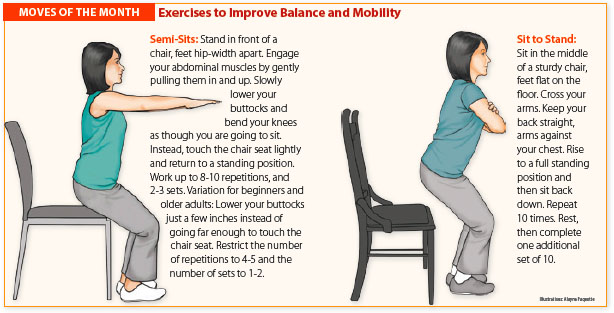Maintain Your Balance and Mobility
Falls are the leading cause of both fatal and non-fatal injuries, according to the National Council on Aging (NCA). Every 11 seconds, an older adult is treated in an emergency room for a fall. One out of every four Americans over 65 falls every year; and every 19 minutes, an older adult dies from a fall, the NCA reports.
Part of this can be attributed to age-related sarcopenia—the loss of muscle mass due to aging. People who are physically inactive can lose as much as 3 percent to 5 percent of their muscle mass every year. Over a few decades, that can really add up and wreak havoc on your balance and mobility.
“Loss of muscle mass leads to weakness, which can then lead to a decrease in functional ability or the ability to do daily living activities,” cautions Kelyssa Hall, an exercise physiologist with the Weill Cornell-affiliated Hospital for Special Surgery.
But falling, and sarcopenia, are not inevitable as you age. “Daily exercise can help maintain and improve strong muscles and bones and can help keep joints, tendons, and ligaments flexible, and avoid injury during everyday activities,” says Hall. “Exercise can help maintain and improve the coordination and balance required for daily movements. It also helps build bone density, which can help in preventing osteoporosis. Even a small amount of exercise can make a difference.”

Stay Active
One of the biggest threats to your mobility is being sedentary. It’s normal to become less active as you age, but that’s why it’s so important to schedule regular activities into your week. “Cardiovascular exercise can help you maintain or lose weight, which can reduce the load and stress on the joints, making it easier to move,” Hall says. “Cardio also can help build muscle, reduce the risk of cardiovascular diseases, increase metabolism and immune system function, increase endurance, and help you manage chronic conditions like diabetes and high blood pressure.”
Bend and Move Correctly
“To stand up from a chair, place your feet flat on the floor hip-width apart and bring your toes underneath your knees,” Hall explains. “Lean forward so your nose is over your toes. Engage your core, push through your heels, and push up with your legs until you reach standing position with a tall straight posture. If you are leaning forward when you take steps, this could lead to falling forward. To sit, make sure your feet are still hip-width apart and flat on the floor. Make sure you can feel the chair on the back of your legs. Then bend at the knees and lower your body to a seated position.”
Build Muscle Mass
“Strengthening all the body’s muscles can help to maintain symmetrical joint support, which leads to more support for functional tasks, as well as providing control when you trip or stumble, reducing your potential for injury.”
The post Maintain Your Balance and Mobility appeared first on University Health News.

